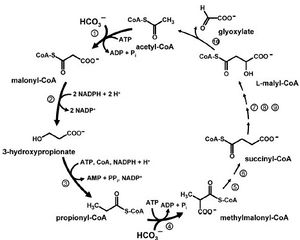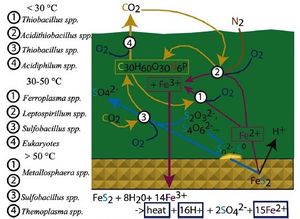Metallosphaera cuprina
Classification
Domain: Archaea
Phylum: Crenarchaeota
Class: Thermoprotei
Order: Sulfolobales
Family: Sulfolobaceae
Genus: Metallosphaera
Description and Significance
Metallosphaera cuprina was originally isolated from muddy hot spring water in the Yunnan province of China and is named in reference to copper, cuprina, due to the extraction of copper from ores near the hotspring. [1]
M. cuprina differs from other species of Metallosphaera as it is more extermophilic and can grow in lower temperatures and higher pH than most. M. cuprina grows best at 65°C, and pH 3.5, but can grow in ranges of 0-1% (w/v) NaCl, 55-75° C, and pH 2.5-5.5. [1]
There is potential for the use of M. cuprina and other Metallosphaera in the mining industry through bioleaching, due to its oxidation of reduced inorganic sulfur compounds. [2] Bacteria are typically used to further oxidize Fe3+-oxidized ore, and regenerate Fe2+. [15]
Genome Structure and Phylogeny
The M. cuprina genome is 1.84Mb [2] and contains 2077 genes [9]. In comparison, Metallosphaera sedula has a 2.19 Mb genome and 2307 genes [16], making the M. cuprina genome16% smaller than M. sedula.
The Ar-4T strain of M. cuprina has a GC content of 40.2 mol%. This is slightly lower than other Metallosphaera species: M. sedula, 46.2 mol% [8]; and Metallosphaera hakonensis, 46.2 mol%[10]; Metallosphaera prunae, 46 mol%[4].
This strain shares sequence similarities of 97.7% with M. hakonensis DSM 7519T, 97.0% with M. sedula DSM 5348T, and 96.8% with M. prunae DSM 10039T. [1]
Through 16S rRNA gene sequence analysis, it is observed that M. cuprina shares less than 90% similarities with the Acidianus genera, and less than 88% similarities with the Sulfolobus genera. [1]
Cell Structure, Metabolism and Life Cycle
M. sedula is a cocci, roughly 1um in diameter with pilus-like structures protruding from its surface when viewed via electron microscopy [1].
M. Sedula is an obligate aerobe that grows best at 75C and pH 2.0 [1]. The high level of physiological diversity it displaces is relatively unique amongst extremophiles. It is capable of heterotrophic growth using complex organic molecules (with the exception of sugars [1]), autotrophic growth by the fixation of carbon dioxide in the presence of H2 through an proposed modified 3-hydroxypropionate cycle [8], and its highest rates of growth are seen when grown mixotropically on casamino acids and metal sulfides [2]. The dissimilatory oxidation of iron and sulfur in M. sedula, driven by its membrane oxidases, is key to M. sedula’s ability to mobilize metals and bioleach. When grown in the presence of H2, the ability of M. sedula to leach copper from chalcopyrite (CuFeS2), is reduced [7].
Ecology and Pathogenesis
M. sedula can be found in sulfur rich hot springs, volcanic fields, and in acid mine drainage (AMD) communities. These communities are characterized by high metal ion concentrations, low pH and high temperatures. [1] [9] [10]
Though the dissolution of pyrite in AMD is a natural process, it is accelerated the presence of acidophiles such as M. sedula that are found in these environments, thus leading to increased rates of acidification of water draining for active and abandoned mines. AMD communities are characterized by a diverse composition of microorganisms that fill available niches depending on their tolerance to temperature, metal resistance and pH. These communities display a complex symbiosis through the biogeochemical cycling of sulfur, iron, carbon and nitrogen. At high temperatures, M. sedula fills the niche of iron and sulfur oxidizer, a role that is filled by other acidophiles such as the mesophilic Ferroplasma spp and Leptospirillum spp at lower temperatures. [10]
References
1. Huber, G. ,Spinnler, C. , Gambacorta , A., and Stetter, K. “Metallosphaera sedula gen. and sp. nov. Represents a New Genus of Aerobic, Metal-Mobilizing, Thermoacidophilic Archaebacteria”. Systematic and Applied Microbiology. 1989. p. 38-47.
2. Auernik, K., and Kelly, R. “Physiological Versatility of the Extremely Thermoacidophilic Archaeon Metallosphaera sedula Supported by Transcriptomic Analysis of Heterotrophic, Autotrophic, and Mixotrophic Growth”. Applied and Environmental Microbiology. 2010. p. 931-935.
3. Clark, T., Baldi, F., And Olson, G. “Coal Depyritization by the Thermophilic Archaeon Metallosphaera sedula”. Applied and Environmental Microbiology. 1993. p. 2375-2379.
4. http://www.epa.gov/oaqps001/sulfurdioxide/
5. http://www.epa.gov/acidrain/what/index.html
6. Peeples, T.L., and Kelly, R.M., “Bioenergetics of the metal/sulfur-oxidizingextreme thermoacidophile, Metallosphaera sedula”. Fuel. 1993. p. 1577-1752.
7. Auernik, K and Kelly, R. “Impact of Molecular Hydrogen on Chalcopyrite Bioleaching by the Extremely Thermoacidophilic Archaeon Metallosphaera sedula”. Applied and Environmental Microbiology. 2010. p. 2668-2672.
8. Alber, B., Kung, J., and Fuchs, G. "3-Hydroxypropionyl-Coenzyme A Synthetase from Metallosphaera sedula, an Enzyme Involved in Autotrophic CO2 Fixation". Journal of Bacteriology 2008. p. 1383-1389
9. http://genome.jgi-psf.org/metse/metse.home.html
10. Baker, B., and Banfield, J. "Microbial Communities in Acid Mine Drainage". FEMS Microbial Ecology. 2002. p. 139-152
11. Auernick, K. S., Maezato, Y., Blum, P. H., Kelly, R. M. “The Genome Sequence of the Metal-Mobilizing, Extremely Thermoacidophilic Archaeon Metallosphaera sedula Provides Insights into Bioleaching-Associated Metabolism”. Applied and Environmental Microbiology. 2008. p. 682-692
Author
Page authored by Stephanie Napieralski and Caitlin Miller, students of Prof. Jay Lennon at Michigan State University.
<-- Do not remove this line-->



